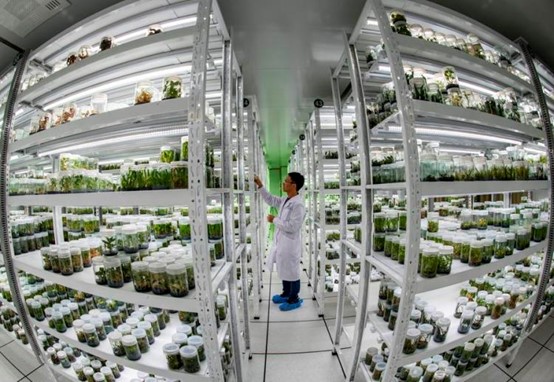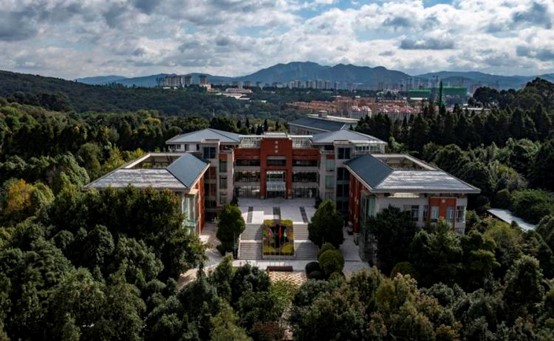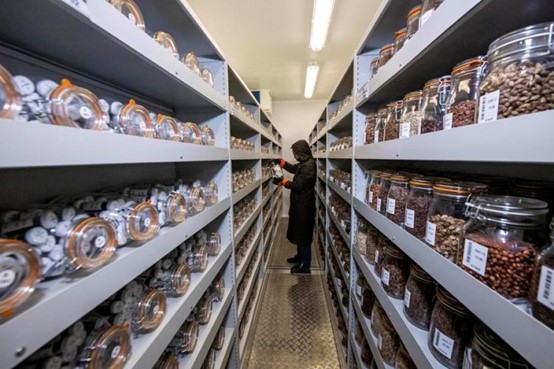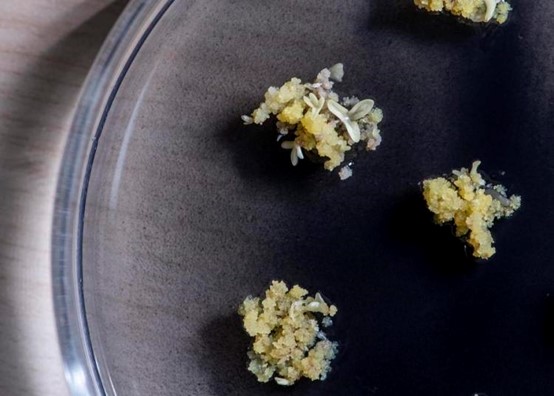

For some, life is put on pause at the very beginning.
In the basement of a four-story building in southwest China's Yunnan Province, hundreds of thousands of precious plant seeds are carefully stored at minus 20 degrees Celsius.
This Germplasm Bank of Wild Species (GBOWS), located in the northern suburb of Kunming, the provincial capital, is the largest facility of its kind in Asia. It houses more than 94,000 plant seed accessions from over 11,000 wild species, representing over one-third of China's wild seed plants.
The seeds are carefully stored in specially designed glass bottles, which are lined up in rows of shelves in a concrete warehouse located 30 meters underground.
According to Cai Jie, head of the seed bank's germplasm collection center, in 1952, Chinese researchers discovered ancient lotus fruits in the peat layer of a dried-up pond in Pulandian, located in northeast China's Liaoning Province.
Lab tests determined that these fruits had been buried underground for approximately 1,288 years. Surprisingly, the seeds inside the fruits successfully germinated and grew into beautiful flowers after their tough outer shells were ground, he said. "This magical discovery has had a profound impact on my career."
"Seeds are natural time capsules, carrying the genetic code of plants. They can revive at the right moment. We preserve seeds with great care because we need to have reverence for nature and believe in the power of life," Cai explained.

Aerial photo taken on Oct. 20, 2021 shows an outside view of the Germplasm Bank of Wild Species in Kunming, southwest China's Yunnan Province. (Xinhua/Jiang Wenyao)
Founded in 2007, the GBOWS project run by the Kunming Institute of Botany under the Chinese Academy of Sciences (CAS) includes a seed bank, a plant tissue bank, a DNA bank, a microbial bank, an animal germplasm resource bank, and other sectors.
Dubbed the "Noah's Ark" of plants in China, the GBOWS is a leading comprehensive research and preservation facility for the germplasm of rare and endangered plants in Asia, serving as a refuge for wild plants in the country.
"When a species faces extinction, we could use these preserved germplasm resources to revive it," Cai said. "I really hope such a day never arrives."
China, despite its incredibly rich biodiversity, is facing a grim situation in wild plant conservation. Research has revealed that among the country's higher plants, at least 4,000 species are threatened, constituting 10 percent of the total, according to Cai.
Since the genes of most plants are contained in their seeds, germplasm resources have become crucial carriers of the genetic information of plants. Chinese scientists have been actively collecting seeds from endangered or rare wild plant species and storing them in seed banks.
CHALLENGING PROCESS
However, it's challenging for a seed to qualify for inclusion in the GBOWS due to strict entry standards. Seeds must first meet the "3E" criteria: they must be endangered, endemic, and economically significant.
The term "endemic" not only refers to the species unique to China but also those exclusive to specific regions. Based on these criteria, nationally and provincially rare and endangered plants, such as the Himalayan yew and the Qiaojia five-needle pine, or Pinus squamata, as well as China's endemic Yunnan maple, are given priority for preservation.
In addition to meeting the "3E" criteria, the seeds must undergo over 70 procedures, with the most crucial being three stages, namely, collection, examination and storage, Cai said.

Photo taken on Oct. 20, 2021 shows seeds stored at the Germplasm Bank of Wild Species in Kunming, southwest China's Yunnan Province. (Xinhua/Jiang Wenyao)
Recalling his unforgettable experience in south China's Guangxi Zhuang Autonomous Region, Cai described the seed collection process as meticulous and full of surprises.
"When we cut off the branches full of fruit, we instinctively used our bare hands to catch them. However, we quickly realized it was a bad idea as a sharp, stinging pain shot down from the back of our hand to our arm and then straight to the heart," Cao said.
"We washed our hands with soap and water, and even tried using urine, but none of these methods relieved the pain. It wasn't until a few days later, when the plant's toxicity had diminished, that the stinging finally subsided," Cai added.
It was later discovered that this plant Boehmeria nivea is a member of the nettle family, and has spines on its fruit containing a toxic substance that induces severe pain in the human body.
Cai said that such "painful" encounters are part of their job, but each seed collection experience is "precious." "I often think that if we missed saving one species, it could face extinction. What a tremendous loss that would be."
To ensure genetic diversity, researchers gather seeds from various locations where the same plant species grows.
It is ideal to collect over 10,000 mature and plump seeds per sample, or a minimum of 2,500 seeds. However, it is crucial to ensure that the collection does not exceed 20 percent of the available seeds in the original population to avoid jeopardizing the plant's regeneration.
To better protect these rare seeds and assist in future ecological restoration, the researchers record detailed information such as collection time, location, altitude, soil type and surrounding environment. They also preserve the plants' twigs with leaves, flowers and fruits as herbarium vouchers to create a "DNA ID" for the seeds in the future.
"The 'DNA ID' provides a molecular genetic pedigree for the accurate conservation of species in our country, and lays a solid foundation for future germplasm utilization and ecological restoration," Cai said.

Photo taken on Oct. 20, 2021 shows seeds stored in a room chilled by refrigeration system at the Germplasm Bank of Wild Species in Kunming, southwest China's Yunnan Province. (Xinhua/Jiang Wenyao)
The collected seeds must undergo procedures such as drying, cleaning and counting before they can be stored. Ordinary seeds, such as corn and wheat, can be stored at room temperature for up to two years. To extend the seed's storage time, low temperature and dryness are used to prolong the seed's lifespan.
"Some seeds are incredibly small, like those from certain orchid plants, which are only tens of micrometers in size. Cleaning these seeds presents a significant challenge, not to mention counting them accurately," said Qin Shaofa, a GBOWS seed curation supervisor.
Due to static electricity in the drying room, seeds from orchid plants often stick to weighing instruments, making them difficult to remove.
"To avoid losses, we can only extract a portion of the seeds for weighing, calculate the average weight, and determine the number of seeds by weighing the total weight," Qin explained.
Before counting the seeds, a random sample is taken and examined using an X-ray machine, so scientists can easily see whether the seeds are plump or shriveled.
After examination, the seeds undergo another round of cleaning, quality testing, counting and drying. They are then stored at 15 degrees Celsius with a balanced relative humidity of 15 percent for one month to induce dormancy.
Finally, after being sorted into sealed containers according to size, the seeds enter their "hibernation" stage in cold storage at minus 20 degrees Celsius.
Each species' seeds are divided into two parts: one stored in the basic repository for permanent preservation, and the other in the active repository for germination testing and research purposes, Qin said.

Photo taken on Oct. 20, 2021 shows somatic embryogenesis of cryopreserved embryogenic cells at the Germplasm Bank of Wild Species in Kunming, southwest China's Yunnan Province. (Xinhua/Jiang Wenyao)
NEW TECHNOLOGY FOR PERMANENT PRESERVATION
"At present, we are working on the technology of seed cryopreservation. If successful, seeds will be placed in liquid nitrogen at minus 196 degrees Celsius after special treatment, which may achieve permanent preservation of seeds," said Lin Liang, a senior engineer at the Kunming Institute of Botany.
Cryobiotechnology is the combination of ultra-low temperature preservation technology and a regeneration system.
Clad in a full-body protective suit to shield against the extreme cold of liquid nitrogen, Lin carefully extracted embryos from magnolia tree seeds stored in a cryopreservation tank. The embryos were then tested to determine if they would successfully regrow upon thawing.
Cryobiotechnology plays an important role in the long-term conservation of recalcitrant seeds, endangered plants, important crops and their wild relatives, Lin said.
"Many wild plants have genes that help them to survive in harsh environments and make them disease or drought-resistant. In the future, we might need these genetic materials to breed new crops that can better adapt to the changing climate," he added.
However, the seeds will not remain in hibernation indefinitely. "Every five or ten years, we break the seed dormancy, take a small sample, and conduct germination experiments to assess their viability," said Yang Juan, a GBOWS seed germination supervisor.
Cai underlined the seed bank's direct impact on people's daily lives, highlighting wild rice as a prime example.
The genes of hybrid rice, developed by the late renowned Chinese scientist Yuan Longping, are derived from wild rice. In 1970, Yuan's team discovered male sterile plants of wild rice in China's southernmost province of Hainan. Years later, they successfully bred hybrid rice using these wild rice plants, greatly increasing rice yields in China.
"As the late renowned botanist Wu Zhengyi had said, a species affects a country's economy, and a gene relates to a country's prosperity," Cai said.
Speaking about future plans, Cai said they will advance international cooperation on seed collection and duplication.
"Seeds symbolize life and hope. It's our common responsibility to better protect the future of humanity," Cai said. (Xinhua)

86-10-68597521 (day)
86-10-68597289 (night)

86-10-68511095 (day)
86-10-68512458 (night)

cas_en@cas.cn

52 Sanlihe Rd., Xicheng District,
Beijing, China (100864)

